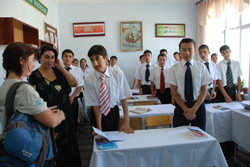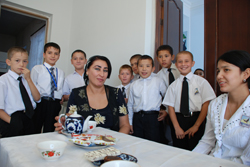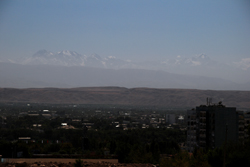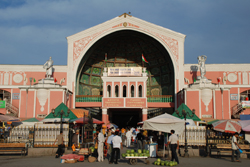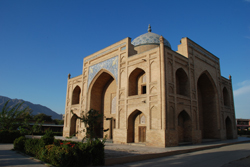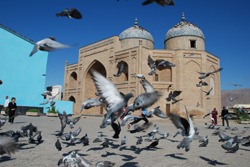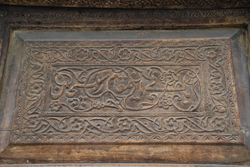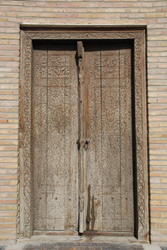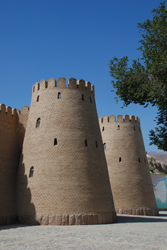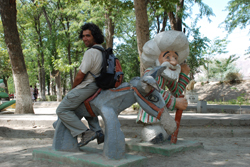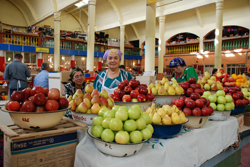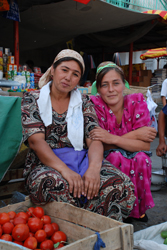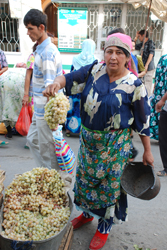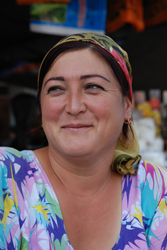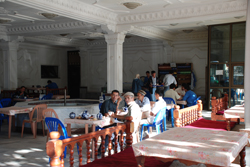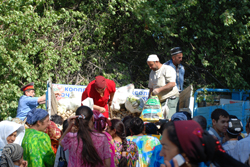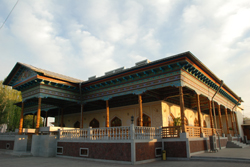Khojand Part 3: Visiting a school
7 September, 2008, 03:26 am in "Tajikistan"
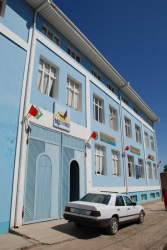 As we were walking through town, some school kids said, "hello." Rowshan responded in Farsi and the teacher, who was with them, asked if he was from Iran. Rowshan talked with the students and teacher for a bit. They were from a private school where they tried to encourage deeper exploration of subjects and included outings around the city as part of the curriculum. The teacher invited us to visit the school.
As we were walking through town, some school kids said, "hello." Rowshan responded in Farsi and the teacher, who was with them, asked if he was from Iran. Rowshan talked with the students and teacher for a bit. They were from a private school where they tried to encourage deeper exploration of subjects and included outings around the city as part of the curriculum. The teacher invited us to visit the school.The school was called The Rustamov Yud School and was a small multistory building. We walked in and saw everyone took off their shoes as if they were in a home. Later the teacher, Firuza, explained the building had been a home and was donated to the school by its founder.
She explained that the school was the only private school in Tajikistan which didn't use a government provided building. She gave us a quick tour pointing out posters with photos of students who had won awards at an educational Olympiad. The young children had Saturdays off and some of the older ones had a rehersal for the Independence Day celebration.
We visited the 10th graders during their history class. A few spoke some phrases in English. One girl translated a message of greeting to the Iranian people for Rowshan to bring to Iran. Rowshan told them the countries we had been to and had them name the capitals.
One boy up front told me in English how it was really important for him to learn English to work on relations between the US and Tajikistan and because he hoped to work in the US or do business between the US and Tajikistan. He said he'd been practicing English for 3 months. I was impressed by the complexity of the ideas he was trying to express even though he'd been studying for such a short time.
We left the kids to their history class and went down to have tea with a couple teachers. Fairuz mentioned the students were involved with the Jr. Achievers program. She also explained how they offered electives such as dance, chess and karate. Some of the younger kids joined in first peaking through the door, then gathering around us.
We met the founder's wife and later, the head of the school who was the son of the founder. He asked about private schools in America. It occurred to me that I was getting the feeling I used to get in the Peace Corps that a lot more importance than we deserved was being placed on us. I told him there were many private schools and probably every year more started because parents were frightened about sending their kids to public schools (and the quality of the public schools wasn't great). That said, I told them I didn't have any personal experience because I went to a (good) public school.
I was once again inspired by the hospitality of the Tajik people. It was an interesting visit. We enjoyed seeing the innovative and high quality school. Of course the kids were from wealthy, educated families: doctors, lawyers, etc. But even so, they seemed more enthusiastic about learning than many kids I've met from similar circumstances.
I was once again inspired by the hospitality of the Tajik people. It was an interesting visit. We enjoyed seeing the innovative and high quality school. Of course the kids were from wealthy, educated families: doctors, lawyers, etc. But even so, they seemed more enthusiastic about learning than many kids I've met from similar circumstances.
Khojand Part 2: A Central Asian City
6 September, 2008, 03:13 am in "Tajikistan"

Though mountains rise up to the North, East, and South of Khojand, the town itself is very flat. It has tree lined streets and is fairly clean. It has a lot of modern looking stores (in comparison to Kyrgyzstan) but also a lot of Soviet concrete buildings and monuments.
Khojand was the first city we visited in Central Asia that din't feel completely Russified. By the bazaar, there was a mosque with blue tiled domes, a brick minaret, and a brick mausoleum with beautiful carved wood doors. The bazaar's main building, though it was a Russian building, incorporated Persian designs.
Of course, this makes sense since unlike many cities in Kazakhstan and Kyrgyzstan, Khojand was a big city before the Russians showed up.
The old city walls are now big piles of dried mud, though they reconstructed sections of the fortifications with more permanent bricks. There was a park at the foot of the walls where there were sculptures of Nasredin Hoca and other children's book characters.
At lunch we discovered the area had delicious apricot juice available for extremely cheap in restaurants and the bazaar. The bazaar is a large Central Asian bazaar with sections of nuts, oriental salads, meats, and produce. Outside the main bazaar, Rowshan took photos of some of the produce sellers.
The women were delighted to have him photograph them and most chatted with him in Farsi/Tajik and me in Russian. A couple gave us gifts of fruit. It is such a contrast to people in South America who don't want photos taken or demand money. The women were friendly and laughed lots. Most of them wore dresses that make me think of Hawaiian mumus-- a yoke above the chest and then lots of fabric loosely falling to calf or ankle.
Some draw with a eyebrow pencil across the top of the bridge of their nose to connect their eyebrows. This is how the women in Persian miniatures look. It is quite a different aesthetic from the eyebrow plucking done in the US. Rowshan also noted that they spoke with Persian which was more correct than the Persian spoken in Iran. Perhaps the Tajiks are more close to the Persians of the past than the Iranians. We rested at a chaihane and were given a thorough questioning by the guys who worked there.
They served us tea, even though they were technically closed and then didn't charge us for it. Using the public toilet next to the chaihane, I couldn't help laughing that the price included 1 carefully torn square of toilet paper. It brought to mind a really bad joke one of our friends in Istanbul used to tell about how to wipe with one square of toilet paper.
Down the street we noticed people selling vegetables to huge crowds from a truck. We didn't think too much of it but Rowshan stopped to take a photo. A policeman told him it was forbidden. He wouldn't say why. Of course, this made us more curious and we wondered if there was some conflict between collective farmers and the government.
Down the street we noticed people selling vegetables to huge crowds from a truck. We didn't think too much of it but Rowshan stopped to take a photo. A policeman told him it was forbidden. He wouldn't say why. Of course, this made us more curious and we wondered if there was some conflict between collective farmers and the government.
We spent some more time admiring aspects of the city including an ornately decorated restaurant with a carved and painted ceiling that reminded me of Chinese wood architecture except with Islamic and Persian designs.
The hotel price was about $17 for a double. The room included a bedroom, dining room, empty room--which could have been a kitchen if it had appliances, a rather stinky bath, and a thriving colony of roaches, ants, silverfish and some other insect I didn't recognize. When we checked in, water wasn't functioning but we were told it would be on in the evening. In the evening, we saw the water was on, running out of the faucet and out of the water tank in a waterfall over the electrical wiring. There was, however, no hot water from the faucets. The floor manager came in and connected a couple wires on the other side of the bathroom but still there was no hot water. Then a repair man walked in and reported the hot water tank had a leak. He also said it would be the 3rd he'd fixed today. The leaking part, a metal boiler piece was completely rusted. He put a new one in and told us to wait a half hour for the water to heat. But, half an hour later, the water was cut.
Khojand Part 1: The Road to Tajikistan
5 September, 2008, 03:13 am in "Tajikistan"
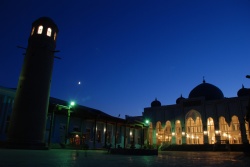 I asked our taxi driver how long the border crossing into Tajikistan took. He said “half an hour to an hour. You'll have to pay the border guards.” The CBT guy in Osh had also mentioned having to bribe the Tajikistan border guards who "Like to find things wrong with your documents or insist you need a frontier permit."
I asked our taxi driver how long the border crossing into Tajikistan took. He said “half an hour to an hour. You'll have to pay the border guards.” The CBT guy in Osh had also mentioned having to bribe the Tajikistan border guards who "Like to find things wrong with your documents or insist you need a frontier permit." At the Tajik border we were sent to an office. One guard was asleep on a bed. There was a tiny shelf of books for reading. An official sat at the desk. He asked his assistant for a note book that was on the table. When the assistant pulled the book from the pile, a 10 som note slipped out.
Rowshan told them he spoke Tajik and the official asked the usual questions and neatly filled out our info in the notebook. When he finished entering the info but still hadn't stamped our passports, I thought, "Oh this is when he will not give us our passports until we bribe him." He dug through the book pile and a 5 Euro note flew out. He told the assistant to remove the notes and sent him looking for some forms. A minute later the assistant returned with some migration forms which we filled out. The official stamped the forms and our passports, kept one copy of the form and gave us the other half along with our passports. Then he sent us on our way. That was it. The driver had been watching through the window. The whole process took about 15 minutes and the officers didn't even suggest a bribe. It was a lot easier and quicker than the Kazakh/Kyrygz border. Maybe it was because Rowshan speaks Farsi which is almost the same as Tajik. Or maybe the border isn't that bad after all.
Once in Tajikistan we found ourselves driving through dry barren rocky hills. I wondered how this could possibly be considered the most fertile part of Tajikistan. Things looked a little greener as we got to Isfara. The driver stopped at the bus station. Before we were even out of the car, we were surrounded by taxi drivers who tried to grab our bags and drag us off to their taxis. Somewhat into their harangue, we noticed our Batken taxi driver. We'd been so busy dealing with the swarm we hadn't paid him. We had agreed to 200 som because we'd heard the price per person is 50 and we got the whole taxi. However he insisted the price was 100 per person. Since I felt bad about getting distracted by the other drivers, we settled for 300 which he seemed a little too satisfied with and quickly disappeared.
We were quickly pulled into another taxi and were soon driving through apricot orchards and by cotton fields where women in bright colored dresses were plucking the white puffs. The road was pretty good in comparison to Kyrgyzstan. Of course, I reminded myself, this is the wealthiest part of Tajikistan. At one point I was surprised to see a large monument reading "Kyrgyzstan" and seeing the sudden appearance of numerous Kyrygz hats. The passenger explained we just went through a tiny piece of Kyrgyzstan, fortunately without border guards. We were soon back in Tajikistan, driving alongside a huge reservoir. We dropped the passenger off in a town and about 15 minutes later, were in Khojand.


